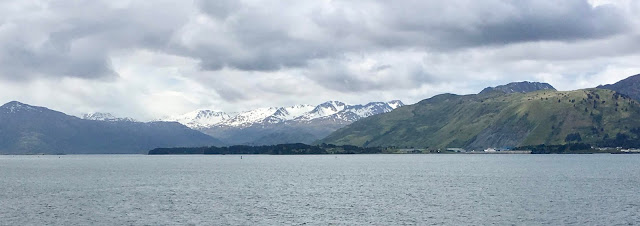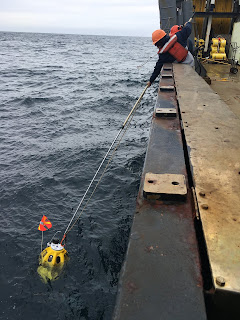Thank you thank you thank you
On June 1, we arrived in port in Kodiak, Alaska, marking the
end of our expedition. Kodiak greeted us with spectacular vistas of mountains
and lush green hills. It’s not called the Emerald Isle for nothing!
 |
| Views of Kodiak on our way into port |
Despite a late departure and some rough weather, it was an
enormously successful trip. We collected a suite of fabulous datasets that will
help us understand the formation of this 6000-km-long chain of volcanos that have formed across the Pacific plate over the last 80 million years. Many mysteries remain about the water-covered
parts of our planet, particularly in remote regions like our study area,
despite the fact that they host truly gigantic structures. Jimmu Seamount is nearly
as tall as Denali, the tallest mountain in North America, and much more massive!
Collecting data that enables us to unravel Earth’s mysteries
requires a huge amount of work from a large group of dedicated people, and I
wanted to use my final blog to thank everyone who made this project possible! During both this research cruise and our
previous cruise focused on the Hawaiian chain, we had wonderful groups of enthusiastic,
hard-working and resilient students and early career scientists who assisted in
data collection and made it possible for us to do a ton of data analysis
onboard and get a first peak at what the data will show us. Acquisition
of marine geophysical data on a sophisticated platform like the R/V Langseth would not be possible without
the entire onshore/offshore team that operates and supports this vessel from LDEO, NSF and other entities, and and the very capable OBS teams from WHOI, Scripps, and GEOMAR. The experience, knowledge and (very, very) hard
work of the Captain, crew, protected species observers and technical staff of
the Langseth and of the OBS teams are
absolutely essential to undertake our science, and we are very grateful for everything they do! Finally, we thank the National Science
Foundation for supporting this type of research, which makes it possible to gain unique insights into earth structure and processes beneath our oceans.
Thank you thank you thank you everyone, and I hope to have the good
fortune to work with all of you again!
 |
| Group photo! |
Donna Shillington
LDEO



When I am alone, I come to see your comments. It is a very good comment, how strange is your loneliness in this city, there are thousands of people but no one is like that. One is changed because you are not there, yesterday even the sunlight did not come on the wall. Thank you from my heart.
ReplyDeleteBlast Photos Gurugram
Call Girls Photos Og Gurugram Girls
call girls in gurugram
Sexy Girls Photos Gurugram
Gurugram escort service
call girls in gurugram
thanks for sharing valuable post on blog commenting. its really helpful window
ReplyDeleteA data lake is a storage repository that captures and stores structured, semi structured, and unstructured data in its native format, without applying any specific data model or schema.Data lakes supporta wide variety of data sources, including structured databases, file systems, sensors, and other machine-generated sources.
ReplyDeleteGreat blog!!! congratulation
ReplyDelete